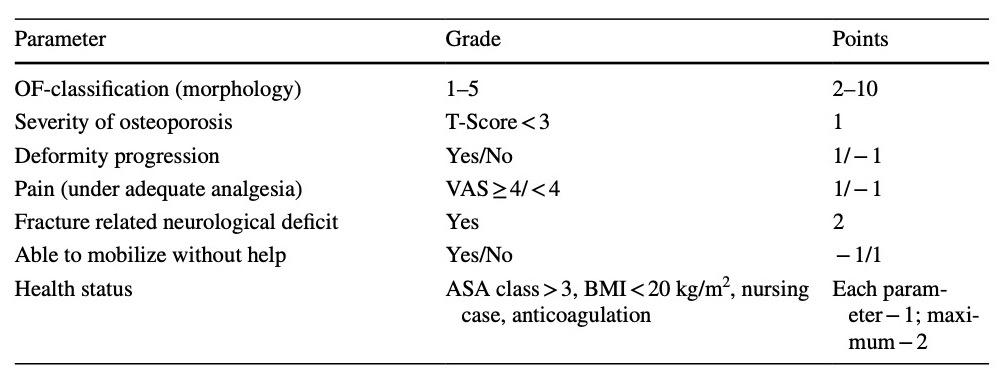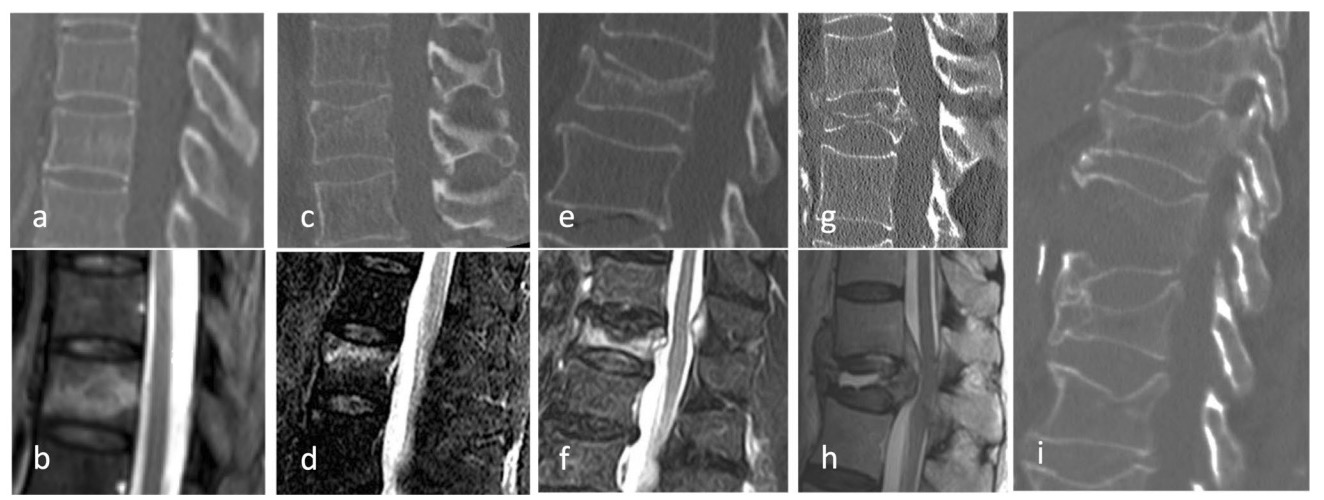Table of Contents
Osteoporotic Fracture Treatment Score
A score of 0 points is given if a parameter is unknown or not determinable. A score of 0–5 points indicates conservative treatment, a score of 6 points indicates indifferent, and a score > 6 points indicates a surgical recommendation. ASA American Society of Anaesthesiologists, BMI body mass index, VAS visual analog scale
OF-classification (morphology)
OF1
a and b OF1 No deformation (vertebral body oedema in MRI-STIR)
OF2
c and d OF 2 Deformation of one endplate
OF3
e and f OF3 Deformation of one endplate with distinct involvement of the posterior wall
OF4
g and h OF 4 Deformation of both endplates with/without posterior wall involvement
Conservative therapy of OF 4 injuries seems to be a viable option in patients with only moderate symptoms. Hybrid stabilization was the dominant treatment strategy leading to promising clinical short-term results. Stand-alone cement augmentation seems to be a valid alternative in selected cases 1)
OF5
i OF5 Injuries with tension band failure
For patients with type OF 5 fractures, surgical stabilization was the treatment of choice and lead to significant short-term improvement in terms of functional outcome and quality of life despite a high general complication rate 2)
A prospective multicenter cohort study (EOFTT) in 17 spine centers. All consecutive patients with Osteoporotic vertebral compression fractures were included. The decision for conservative or surgical therapy was made by the treating physician independent of the OF score recommendation. Final decisions were compared to the recommendations given by the OF score. Outcome parameters were complications, Visual Analogue Scale, Oswestry Disability Index, Timed Up and Go test, EQ-5D-5L , and Barthel Index.
In total, 518 patients (75.3% female, age 75 ± 10) years were included. 344 (66%) patients received surgical treatment. 71% of patients were treated following the score recommendations. For an OF score cut-off value of 6.5, the sensitivity and specificity to predict actual treatment were 60% and 68% (AUC .684, P < .001). During hospitalization overall 76 (14.7%) complications occurred. The mean follow-up rate and time were 92% and 5 ± 3.5 months, respectively. While all patients in the study cohort improved in clinical outcome parameters, the effect size was significantly less in the patients not treated in line with the OF score's recommendation. Eight (3%) patients needed revision surgery.
Patients treated according to the OF score's recommendations showed favorable short-term clinical results. Noncompliance with the score resulted in more pain and impaired functional outcome and quality of life. The OF score is a reliable and safe tool to aid treatment decisions in OVCF 3)

